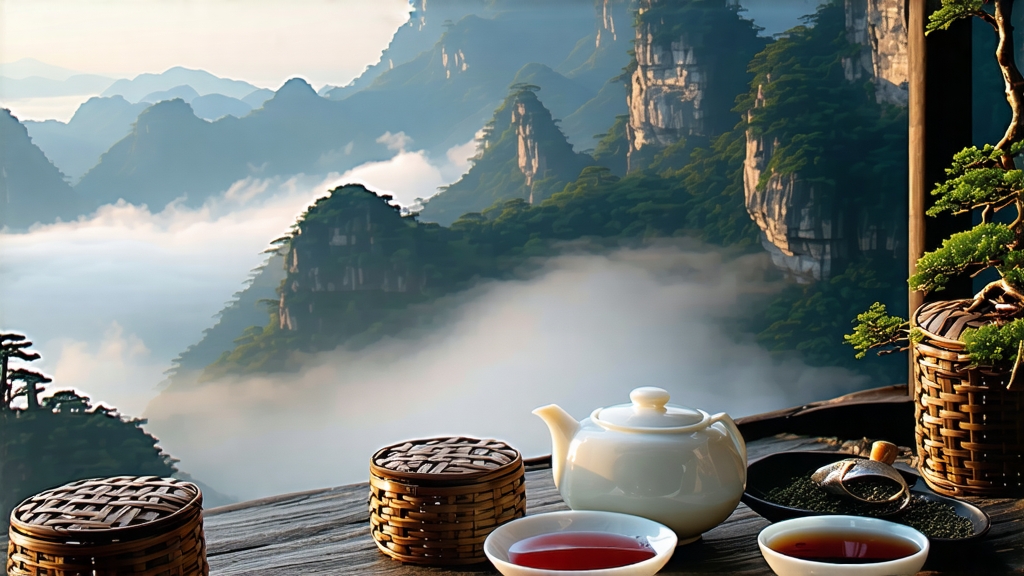
Long before English breakfast blends and Assam malts filled European cups, a small village in the Wuyi Mountains of northern Fujian produced the very first black tea the world ever tasted. Locals call it Zheng Shan Xiao Zhong; foreigners, remembering the old trading post of Tong Mu Guan, corrupted the name into Lapsang Souchong. Whatever the pronunciation, the tea carries within its curled, pitch-black leaves the dual DNA of Chinese craft and global history: it was here, around 1610, that growers first allowed fresh leaves to oxidise fully before firing, inventing the category that would later be dubbed “black” in the West. In the smoky, resin-scented drying rooms of Xingcun village, they also discovered that burning pine logs imparted a flavour so distinctive that Catherine of Braganza, the Portuguese princess who married Charles II in 1662, made it the fashionable drink of the English court and, by extension, the Atlantic world.
Geography is the first secret. The national nature reserve that cradles Tong Mu Guan rises from 600 m to 1 800 m above sea level; morning fog drifts off the Chongyang and Tongmu rivers, filtering sunlight and forcing the tea bushes—mostly small-leaf cultivars of Camellia sinensis var. sinensis—to develop slowly. The cool nights thicken cell walls, concentrating amino acids and sugars that later translate into cocoa-sweet depth and a mineral bite reminiscent of wet slate. Because the reserve bans pesticides and chemical fertilisers, insect pressure is high; leaves become smaller, more aromatic, and slightly tougher—ideal for withstanding the rigours of withering and smoking.
Two traditional styles survive today. “Classic” or “smoked” Lapsang is withered over embers of local Masson pine in a two-storey wooden house called a qinglou. Craftspeople spread the leaves on bamboo screens set one metre above the hearth; pine boughs are fed every twenty minutes so that cool, aromatic smoke—not flames—kisses the leaf for six to eight hours. Once the leaf is supple it is rolled, oxidised for four hours in cedar-lined trays, then baked again over lower pine embers until only 3 % moisture remains. The result is a glossy, charcoal-black strip that smells of campfire, dried longan and wintergreen. The second style, “unsmoked” or “modern” Lapsang, appeared in 2005 for markets that wanted the tea’s natural honey and dried-fruit notes without resin. It follows the same withering, rolling and oxidation steps but is dried with hot air in an electric oven, yielding a lighter, burgundy-coloured infusion and a fragrance of caramelised lychee.
Craft still rules every stage. Hand-picking limits the pluck to one bud and two leaves taken before the Qingming festival, when spring chill lingers and buds are tight. Withering begins within thirty minutes of plucking; on cold mornings workers carry the bamboo baskets into the sunshine, turning them every ten minutes to ensure even moisture loss. Oxidation is judged not by clock but by nose: when the green grassy note disappears and an apple-raisin aroma emerges, the leaf is quickly hot-pan-fired at 200 °C for ninety seconds to arrest enzymes. The final pine-smoke bake is a ritual passed from father to son: only pinewood aged three years is used; resinous fresh logs would blister the leaf and leave a kerosene taint. A master can tell by the crackle of the embers whether the temperature has drifted 5 °C and will adjust the depth of the ash bed with a bamboo rake in seconds.
To brew Lapsang like a tea master, forget the teabag. Use a small 120 ml porcelain gaiwan or a Yixing pot seasoned only with black teas. Weigh 4 g of leaf—about two heaping teaspoons—and rinse for three seconds with 95 °C water to wake the aromas. The first proper infusion should last ten seconds; subsequent steeps lengthen by five seconds each time. A good smoked Lapsang will deliver at least six layers: the opening cup is pine and wintergreen; the second, candied plum; the third, dark cocoa; the fourth, burnt cream; the fifth, mineral wet stone; the sixth, lingering dried longan sweetness. If you prefer Western style, use 2.5 g per 250 ml mug